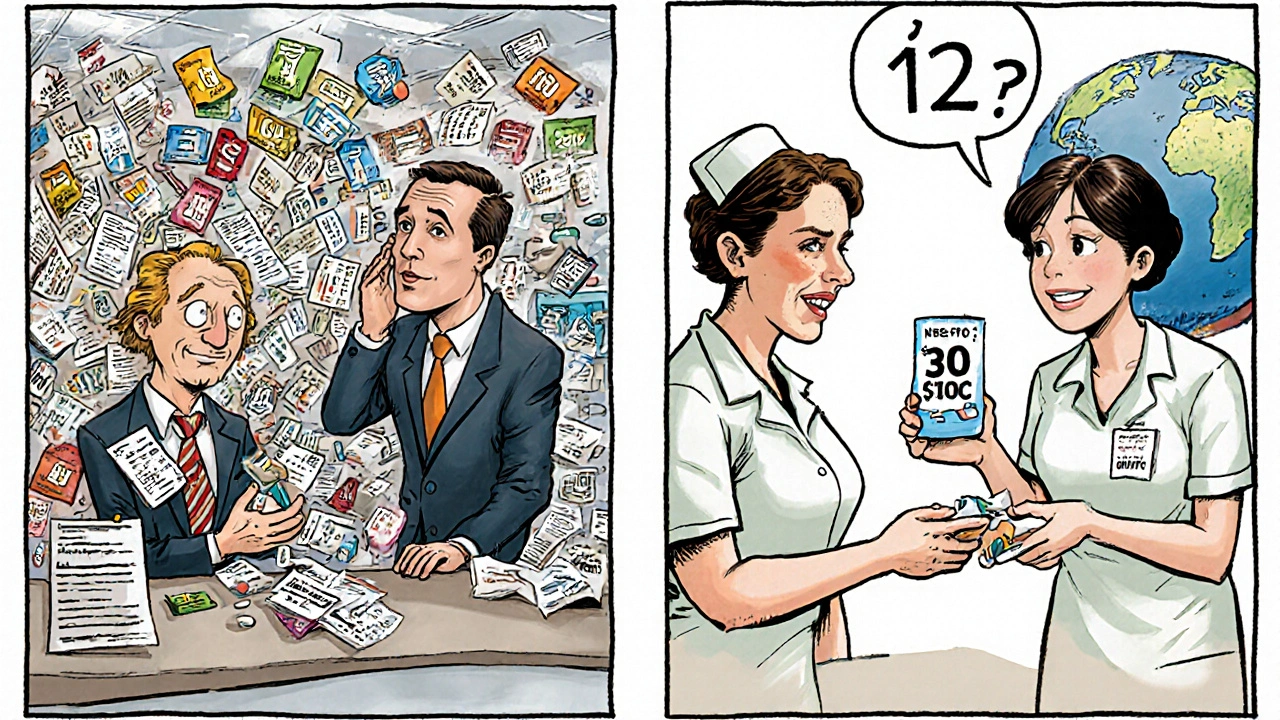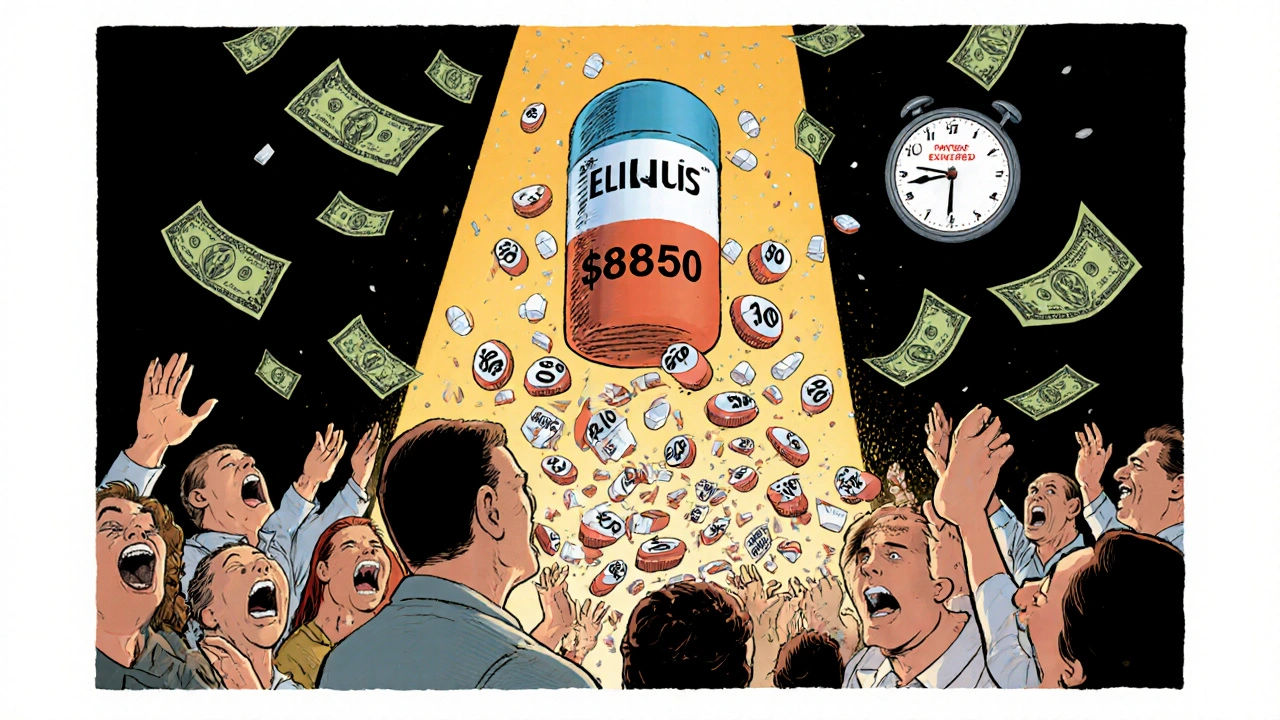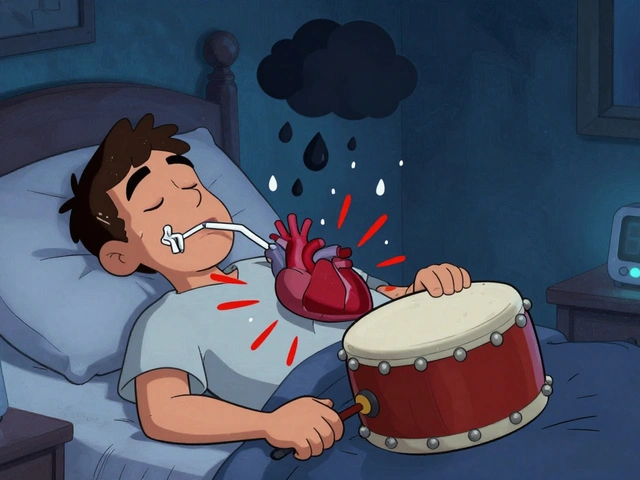When a drug’s patent runs out, something powerful happens: prices don’t just dip-they plummet. For patients paying hundreds of dollars a month for a brand-name medication, that moment can mean switching from a $850 prescription to a $10 generic. It’s not magic. It’s economics. And it’s happening right now with drugs like Eliquis, Humira, and Ozempic.
What happens when a patent expires?
A pharmaceutical patent gives a company exclusive rights to sell a drug for about 20 years. During that time, they’re the only one who can make it. That means they set the price-no competition, no pressure. But once the patent expires, other companies can legally produce identical versions called generics. And that’s when the real price drop begins. The first generic to enter the market usually cuts the price by 15% to 20%. That’s noticeable, but not dramatic. Then comes the second. Then the third. By the time five or six companies are selling the same drug, prices can drop 70% or more. In the U.S., after eight years, some drugs lose over 80% of their original price. A 2023 study in JAMA Health Forum found that for 505 drugs analyzed, the average price fell 82% over eight years after patent expiration. It’s not just about more companies. It’s about competition. When there’s only one seller, they can charge what they want. When there are 10, they’re fighting for shelf space, for pharmacy contracts, for patient trust. That’s when prices really start to slide.Why do some drugs drop faster than others?
Not all drugs are created equal. Small molecule drugs-like blood thinners, statins, or antidepressants-are relatively easy to copy. Their chemical structure is simple to replicate. That’s why drugs like Lipitor and Plavix saw massive price drops within months of patent expiration. But complex drugs, especially biologics like Humira or Enbrel, are different. These aren’t just pills. They’re made from living cells. Copying them isn’t as simple as mixing chemicals. The copies are called biosimilars, and they take longer to develop, test, and get approved. That’s why Humira’s patent expired in 2016, but the first biosimilar didn’t hit the market until 2023. Even then, the price didn’t crash right away. AbbVie, the maker of Humira, filed over 130 secondary patents on minor changes-delivery devices, dosing schedules, formulations. These didn’t make the drug better, but they delayed competitors. It’s called a “patent thicket,” and it’s a common tactic. The R Street Institute found that 78% of new patents filed between 2010 and 2020 weren’t for new drugs-they were for old ones with small tweaks.Why do prices vary so much between countries?
The same drug can drop 82% in the U.S. but only 18% in Switzerland. Why? It comes down to how each country handles drug pricing. In the U.S., there’s no central price negotiation. Pharmacies, insurers, and PBMs (pharmacy benefit managers) all negotiate separately. That creates a messy, fragmented system. When generics enter, some payers jump on the lower price. Others stick with the brand because of rebates or contracts. That’s why patients sometimes see a big drop, but their insurance still pays a lot. In Europe, governments set price caps. They negotiate bulk deals. If a generic comes in at half the price, they just switch the official reimbursement rate. That’s why countries like the UK and Germany saw 60%+ price drops within a few years. Australia uses a reference pricing system: if a drug’s price falls in one country, they match it. That creates a domino effect. Switzerland, on the other hand, has strict rules limiting how low prices can go-even with competition.Who benefits when prices drop?
Patients. Insurers. Medicare. Medicaid. Taxpayers. Everyone who pays for healthcare. A 2023 Kaiser Family Foundation survey found that 68% of insured adults saw lower out-of-pocket costs when generics became available. For someone taking Eliquis (apixaban), that meant going from $850 a month to $10. That’s not a savings-it’s a lifeline. Medicare Part D saved $11 billion in 2023 just from generic and biosimilar use. The Congressional Budget Office estimates that over the next decade, generic and biosimilar competition will save the U.S. healthcare system $1.7 trillion. But here’s the catch: not everyone feels it right away. Even when generics are available, insurance formularies can delay access. Some plans require patients to try the brand first. Others don’t cover the generic unless the doctor writes “dispense as written” on the prescription. Pharmacists can’t substitute unless the law allows it-and rules vary by state.What’s holding back faster price drops?
The biggest barrier isn’t science. It’s strategy. Originator companies know their profits will vanish once generics arrive. So they fight to delay them. Tactics include:- Patent thickets: Filing dozens of minor patents to block competitors.
- Pay-for-delay deals: Paying generic makers to wait before launching.
- Restrictive contracts: Forcing insurers to favor the brand in exchange for rebates.
- Complex manufacturing: Making biosimilars expensive and slow to produce.

What’s changing now?
Regulators are starting to push back. In 2023, the U.S. Patent Office tightened rules on patent thickets. The European Commission proposed limits on supplementary protection certificates. The Inflation Reduction Act lets Medicare negotiate prices for some drugs-something that’s forcing manufacturers to rethink their timelines. The European Medicines Agency now wants biosimilars to reach 70% market share within three years of patent expiry. Right now, it’s around 45%. They’re pushing for faster approvals and mandatory substitution rules. Meanwhile, generic drugmakers are investing more in complex drugs. Companies like Amgen and Sandoz are building labs to copy biologics. In 2023, the global generic drug market hit $407 billion. It’s expected to hit $700 billion by 2030.What does this mean for you?
If you’re on a brand-name drug with an expiring patent, ask your doctor or pharmacist: “Is there a generic or biosimilar available?” Don’t assume your insurance will automatically switch you. Check your formulary. Ask if you can switch to the cheaper version. If you’re paying cash, call local pharmacies. Some generics cost less than a coffee. One patient on Reddit reported paying $12 for a 30-day supply of generic metformin-down from $180 for the brand. And if you’re watching a drug like Ozempic or Humira stay expensive even after patent expiration, understand why: it’s not about the science. It’s about contracts, rebates, and legal loopholes. The system works-when it’s not being gamed. The bottom line? Patent expiration is the most powerful tool we have to lower drug prices. But it only works if the system doesn’t block it.How long until a generic hits the market?
It varies. For simple pills: 6 to 18 months after patent expiry. For complex biologics: 3 to 7 years. In the U.S., the average time from patent expiry to first generic is 30 months. In Europe, it’s 12 to 18 months.Do all drugs get generics?
No. Some drugs are too complex to copy easily. Others have such small markets that no company finds it worth the cost. But for the top 100 most-prescribed drugs, 95% have generic versions available within five years of patent expiry.





Kihya Beitz
So let me get this straight - we let pharma companies charge $850 for a pill for 20 years, then act shocked when it drops to $10? Bro, that’s not capitalism, that’s a hostage situation with a prescription pad.
And don’t even get me started on the ‘patent thicket’ nonsense. It’s not innovation - it’s legal graffiti on a monopoly.
I’ve seen my insulin go from $400 to $30 in 6 months. Not because of magic. Because someone finally said ‘fuck you’ to AbbVie. 🤷♀️
Jennifer Walton
There is a quiet violence in the pricing of medicine. It is not in the pill. It is in the choice between rent and refills.
Patents expire. People do not.
Yet the system treats both as interchangeable variables.
Ryan Airey
Stop pretending this is about ‘fairness.’ This is about profit suppression. The second generic hits, and suddenly the drug is ‘cheap.’ But the company that spent $2B developing it? They’re the villain now? Nah. They took the risk. The rest of us just want it free.
And now we’re punishing innovation because we can’t be bothered to pay for it? Welcome to the future where no one develops anything new because why bother?
Hollis Hollywood
I just want to say - I’ve been on Eliquis since 2020. When the generic came out, I cried. Not because I was sad. Because I realized I’d been paying $800 a month for something that cost $3 to make. And I didn’t even know I had options.
My mom had to choose between her meds and her heater last winter. She’s 72. She didn’t complain. She just took half the dose.
That’s not a healthcare system. That’s a moral failure wrapped in insurance paperwork.
And yeah, I know the pharma guys say ‘R&D.’ But if R&D costs $2B, why does the pill cost $850 and not $85? Where’s the math?
Aidan McCord-Amasis
Generic metformin: $12
Brand: $180
My pharmacist: ‘We don’t stock it unless you ask.’
Y’all are being scammed daily and still clicking ‘accept’ on your insurance forms. 😭
Adam Dille
I get why people are mad. But let’s not forget - without patents, we wouldn’t have Ozempic in the first place. No one would’ve spent 15 years and billions trying to make a drug that helps with diabetes AND weight loss if they knew they’d get wiped out after 20 years.
Maybe the answer isn’t to kill patents - but to fix the middlemen. PBMs, insurers, pharmacy contracts… they’re the real villains. The drugmakers? They’re just playing the game we gave them.
Also, I switched to generic Humira last year. No side effects. Saved $700/month. My body didn’t care who made it. Just glad it works. 🙌
Katie Baker
Just wanted to say - if you’re on a brand-name drug and haven’t asked your pharmacist about generics, please do it today.
I thought my insurance ‘automatically’ switched me to the cheaper version. Nope. I had to call three times. Now I pay $8 instead of $700.
It’s not rocket science. It’s just bureaucracy. And you’re allowed to fight it. 💪
John Foster
There is a metaphysical dissonance here. The pill is identical. The chemistry is identical. The molecular structure is identical. The body responds identically.
Yet the price is not identical. Why? Because we have assigned value not to the substance, but to the narrative - the brand, the logo, the corporate mythos of ‘innovation.’
It is not the drug that is expensive. It is the story we tell ourselves about it.
We pay for the illusion of exclusivity. And we call it ‘healthcare.’
When the patent expires, the story dies. But the body still needs the pill.
And so we are left with a choice: do we value the myth… or the medicine?
Edward Ward
One thing no one talks about: the FDA’s backlog. They approved 870 generics last year - that’s great - but the average review time for a complex biosimilar is 2.7 years. And each study costs $2M-$5M. That’s not ‘big pharma blocking’ - that’s a regulatory system that’s underfunded and overwhelmed.
Meanwhile, the EU approves biosimilars in 12 months. Why? Because they have centralized agencies with dedicated budgets. We have a patchwork of contractors, consultants, and paperwork.
So when someone says ‘Big Pharma is stalling,’ yes - but also: our government isn’t stepping up to fix the system that lets them stall.
And don’t get me started on how PBMs get kickbacks from brand drugs. That’s the real rot. Not patents. Not R&D. It’s the middlemen who profit from the confusion.
It’s not a conspiracy. It’s a broken system. And we all helped build it - by not asking questions.
Ask your pharmacist. Ask your doctor. Ask your rep. Then ask again. Until they listen.
Andrew Eppich
The notion that drug prices should be dictated by market forces is a fallacy. Medication is not a commodity like coffee beans. It is a necessity for human survival. To allow profit maximization in the context of life-sustaining treatment is not capitalism - it is moral bankruptcy.
Furthermore, the U.S. is the only developed nation that permits direct-to-consumer advertising of prescription drugs. This is not an accident. It is a deliberate strategy to inflate demand and justify inflated pricing.
Patents are not the issue. The entire framework of pharmaceutical regulation in the United States is corrupt.
And yet, we are surprised when patients ration insulin?
What is wrong with us?
Jessica Chambers
My pharmacist told me the generic version of my antidepressant was $4. I asked why my insurance didn’t cover it automatically.
She sighed and said, ‘Because your PBM gets a rebate from the brand.’
So I’m paying $200 a month so some middleman can get a cut? 🤡
Thanks, America.
Shyamal Spadoni
Big Pharma is owned by the Illuminati and the Fed. They control the patents so they can control the population. The real reason generics are slow is because they don’t want you healthy. They want you dependent. That’s why Ozempic is still $1000 - it’s not about the science, it’s about the mind control. The FDA is a puppet. The WHO is a puppet. Even your doctor is paid to keep you on brand. They gave me a script for Humira even though the generic was approved in 2023. Why? Because they’re paid to lie. I know this because I read a blog post by a guy who used to work at Pfizer. He said ‘the system is rigged.’ And he was right. I’ve seen it. They’re injecting nano-chips in the pills. You think the price drop is real? It’s a distraction. The real drug is in the pen. Watch your blood pressure. It’s not dropping. It’s being monitored.
Ogonna Igbo
You Americans think you own the world because you have patents? We in Nigeria make our own generics. We don’t wait for FDA. We don’t beg for rebates. We just make the medicine. Why? Because our people are dying. You sit in your big houses and cry about $850 pills? We sell $2 pills in Lagos markets. No paperwork. No patents. Just science. You want cheap drugs? Stop crying about IP and start copying like we do. Your system is weak. Your laws are for the rich. We don’t need your patents. We need your pills. And we take them.
BABA SABKA
Let’s cut through the jargon. Patent = monopoly. Generic = competition. Biosimilar = expensive copy. PBMs = middlemen who profit from your suffering. Insurance = gatekeeper. FDA = slow. Pharma = greedy. System = rigged.
And yet we’re shocked when people can’t afford insulin?
Here’s the real issue: the system was designed this way. Not by accident. By design. The goal isn’t health. It’s extraction.
And the worst part? You all keep playing along. You sign the forms. You pay the bills. You don’t revolt.
So don’t act surprised when the machine keeps grinding.
Chris Bryan
China and India are flooding the market with generics. They don’t care about patents. They don’t care about ‘innovation.’ They just make the pill. And now they’re undercutting U.S. pharma. That’s why we’re losing. It’s not about ethics. It’s about national weakness. We let foreign countries dictate our medicine prices because we’re too lazy to fix our own system. Pathetic.
Adam Dille
Wait - so if I’m on Ozempic and the patent expires in 2026, but they’ve got 142 other patents on pens and dosing… does that mean I’ll be paying $1000 until 2036? 😭
So the real game isn’t just ‘delay the generic’ - it’s ‘delay the idea that the generic is even possible.’
That’s psychological warfare.
And we’re the ones holding the prescription.
Someone needs to start a petition to ban patent thickets. Like, right now.